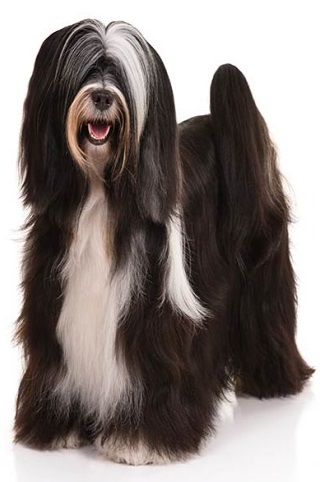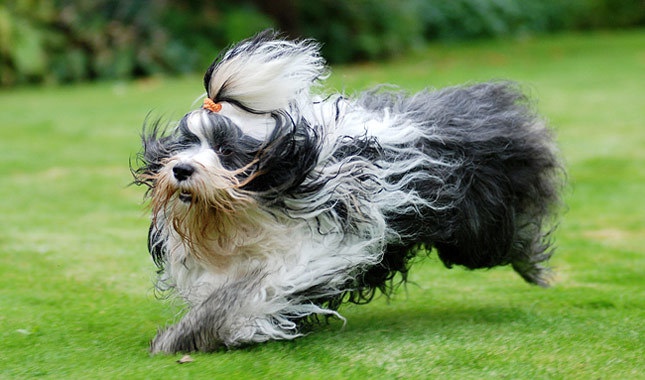A dog is a man’s best friend. But with the Tibetan Terrier, you get a best friend as well as a good luck charm-according to ancient Tibetan monks. The twinkle in its eyes, the long and beautiful hair has with the kindest of temperaments, the Tibetan Terrier is a wonderful pet for a calm family.
The name misleads its true identity as it doesn’t really belong to the Terrier group and was named just because it looked like one of the Terriers. The History and origins of this humble dog will certainly give you goosebumps.

This shaggy dog and it’s mischevious yet forgiving nature compelled me to write this article for you guys. Let me give you a brief description of the dog before we get into the details.
Tibetan Terrier Dog Breed Overview

| Group: | Non-Sporting |
| Size: | Medium (20 – 24 pounds) |
| Lifespan: | 15 to 16 years |
| Best Suited For: | Families |
| Temperament: | Calm, Possessive, Sensible, Outgoing, Fearless, Caring and Agile |
| Exercise Needs: | Moderate |
| Drooling Potential: | Low |
| Grooming Needs: | High |
| Similar Breeds: | Lhasa Apso, Tibetan Spaniel, Lowchen, Bearded Collie |
1. Basic Features
The Tibetan Terrier is a shaggy dog with long hairs and has a square proportion. It is a medium-sized dog that has a compact yet muscular body. The face is moderate and the muzzle is velvety with dark eyes set far apart. You are sure to fall in love with its kind face. The color of their noses varies from black to brown.
The Tibetan Terrier’s coat is something that attracts everyone if kept in good condition.
The fur is also something that makes them winners in most dog-shows.
The growth circle of their hair has a similar rate of growth like that of a human’s hair. They do not shed like other dogs who have shorter growth rates. The coat is double layered with a warm undercoat and a long topcoat possessing texture similar to that of the human hair.
Their legs are the second most attractive thing after their coats. They are flat and look like snowshoes. These help them to navigate the cold and harsh terrain of the Tibetan valley where this dog breed originated.
2. Tibetan Terrier Origin

As the name suggests the Tibetan Terrier have their roots in Tibet where they were raised by monks and nomadic herders. These dogs were considered holy and bringer of luck hence they were never sold. You could only get this dog if it was gifted to you by a monk. Due to the secluded landscape of Tibet, it stayed in its vicinity for thousands of years; recent DNA analysis suggests that this dog breed is one of the ancient dog breeds that ever existed on this planet.
Also known as the “Holy dog of Tibet”, their original name was Tsang Apso which roughly translated to “bearded dog”.
These dogs were considered good companions and were known to protect properties of their owners. The Kennel Club of India later changed its name to Tibetan Terrier.
3. The Personality of Tibetan Terrier
The Tibetan Terrier has a great sense of humor thanks to its intelligent personality and mischevious nature. Even if it acts reserved with unknown people, after getting used to them this dog is sure to get along with them. Such attributes make them a perfect as therapy dogs.
The Tibetan Terrier is an excellent companion (even better than your husband/wife!).
Because it can read your emotions easily and adjust its behavior to keep you happy. If you need some cheering up, the dog sure knows how to do that job.
4. Tibetan Terrier Behavior
The Tibetan Terrier thrives under the presence of people. It loves having people around to keep him company. It becomes lonely and unhappy if kept caged or kept alone and may lead to several behavioral problems. The dog is adaptable to live in almost any kind of environment. It is extremely trainable and so smart that sometimes it figures its own way to get out of locked rooms and crates. The Tibetan Terrier is a friendly dog but also sensitive so it is important to develop a gradual sense of familiarity as it matures slower than other dogs.
5. Exercise Requirements

The Tibetan Terrier is a strong and athletic dog.
It is used to herd cattle flock and hence is agile.
This dog breed will need some kind of regular exercises like a daily walk or some play time to keep up its energy levels and enthusiasm. There are dogs in this breed that will do with little exercises. The dogs love to have a spot in the house where it is able to look outside as if performing a sentry duty.
6. Dietary Needs
The Tibetan Terrier was brought up in the rough terrains of Tibet where the monks use to feed it easily digestible yet nutritious leftover food. Their diet must contain quality protein along with vitamins and minerals that will keep it healthy and satisfied. It is not surprising that the dog will leave a little food in its bowl as it is a lean dog and won’t require larger food proportions. It is important to provide it a quality diet.
7. Trainability
These dogs are very much trainable, so much so that it could participate in rallies if trained properly. The dogs are trainable but you need to have a lot of patience when it comes to training as it gets bored easily. These dogs are smart so instead of the dog most of the time you will get trained by the dog.
One thing that you have to keep in mind while training them is that negative methods should never be used as the dogs would rebel and refuse to learn anything. Consistency and patience is the key to successfully train a Tibetan Terrier.
8. Common Health Problems
The Tibetan Terrier withstood the tough weathers of the Tibetan range and that shows how much immune it is to most diseases.
Nevertheless, these dogs are still susceptible to a number of diseases being second immigrants to the western countries.
Retinal as well as joint diseases are the major ones. Nowadays heart attacks are also common among aging Terriers. Hip disease such as hip dysplasia and eye diseases such as Progressive Retinal Atrophy is common among the breed.
9. Who Should Adopt a Tibetan Terrier?
These are extremely valuable family pets, amiable and affectionate and gentle with supervised children. They thrive in a company and hence should never be left alone for a long time.
That said, it is a breed that is possessive of its resources and it makes hard for other dogs to live peacefully with it, if not trained to do so. They are known to be loyal and faithful and will prove to be an excellent herd dog. These dogs are suitable for small and big apartments and also can double up by taking up the role of a watchdog.
